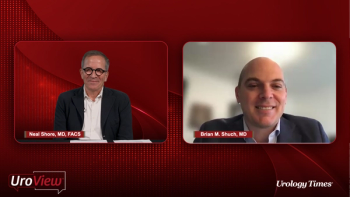
Third-Line Treatments for Overactive Bladder
Overactive bladder experts discuss when they move from one treatment to another, and share pros and cons of available third-line treatments.
Episodes in this series

Scott MacDiarmid, MD, FRCPSC: If a patient is treatment-naive when they see you, how many medications would you try? What do you typically do before you move on to the third line? That may vary, but just give an idea.
Alexandra Rogers, MD: If it’s going to be covered, I move on immediately. For PTNS [percutaneous tibial nerve stimulation] in California, you have to fail 2 medications. That being said, many patients who see me have already tried an anticholinergic medication. For patients who are new or returning, having failed, I’m putting them on the newest beta agonist for 2 weeks. I’m trying to get them to the third line on the next step. When patients come in and have been in pill purgatory for years, I’m talking about Botox, because I find that access to Botox is very easy, it’s well covered for most insurances, and it works very well.
Sacral neuromodulation is a harder discussion, because at times it takes longer for a patient to get on board with that, given what’s involved to get that into a patient. I try to skip through medications quickly, because when you look at medication data, 80% of these patients have quit their medications within a year. Looking at how we’re batting, I’m going to move on from medications as quickly as insurance coverage will allow me.
Scott MacDiarmid, MD, FRCPSC: I’m still a little more conservative. My pathway for the last many years before the new beta-3 agonist was giving mirabegron first, and if that failed, I’d give them 2 prescriptions of generic antimuscarinics and have them come back to see me in 8 weeks. They would have tried 3 medications as monotherapy, or sometimes in combination, and that’s what I call ROAB [refractory overactive bladder]. But everybody practices differently. The bottom line is that I like the fact that you’re showing them the pathway early. There’s no question that it helps people make better, more informed decisions.
Alexandra Rogers, MD: Scott, you asked me about what I deem to be refractory overactive bladder. For me, it’s not just medication failure. If they’re not responsive to 1 or even 2 third-line therapies, then they’re refractory, because I consider it to be ROAB if I’ve exhausted the toolbox.
What are your thoughts on third-line therapies that we have for OAB [overactive bladder]?
Scott MacDiarmid, MD, FRCPSC: Our options include botulinum toxins, sacral nerve stimulation, and percutaneous tibial nerve stimulation. I don’t have a favorite. They all work differently. They’re all imperfectly good. Any one of them can work for an individual. I’ve always had a bias that if I’m going to offer something invasive, I should offer something noninvasive as well, so PTNS is in that discussion with most people. When you have a community continence center, we see a lot of people in their 80s. [The population] becomes elderly in a hurry. They need help, too, so we do a lot of PTNS. But I like all 3 treatments. I’m a surgeon, so I prefer sacral nerve stimulation the most. It’s fun and I like to test. They’re 3 very good options, but we could sure use more tools in the toolbox. What are your thoughts? Is there any standard or best one for you or any biases?
Alexandra Rogers, MD: No. They all have a low share currently despite all being efficacious, and sometimes adherence can be tricky for all of them. But once again, I’m all about choice for patients. In my community, PTNS is the most popular option when not given constraints of acute COVID-19. We have a very robust program where at times we have 1 in 4 new patients with OAB receiving PTNS. I don’t consider any particular one to be the standard of care, with patient input and external factors affecting choice. They should all be acknowledged and offered by incontinence specialists. There’s no one-size-fits-all. They all have their pros and cons that need to be delivered well and managed on the back end.
We can agree that with PTNS, you have to have a team that’s truly dedicated to placing the needle well and giving good counseling to patients, reminding them to stick with it and that it may not kick in until weeks 6 to 12. With Botox, we need to foster a pleasant, easy experience for patients. I keep them on blood thinners. I ignore colonization for the most part. I personally use a reduced injection paradigm so that there’s less discomfort overall. My goal is to keep patients coming back for it, because when we look at data on that, 90% of them quit by the fourth injection. The adherence for Botox in the data sometimes isn’t what we want it to be for this chronic condition, so I try to automatically set them up for the next visit as soon as I confirm that PVR [post-void residual urine volume] is acceptable at 2 to 3 weeks.
I love doing sacral neuromodulation. It’s an art. Regardless of what brand you’re using, it remains very dependent on optimal lead placement and good support on the back end from the team, so that we have excellent management of this costly device and get good long-term success with these patients. You’re signing a patient up for long-term maintenance once they have a sacral device, which can be highly efficacious in the right patient. For those of us who see a fair amount of sacral neuromodulation, we at times need to mitigate nerve fatigue and habituation with stim [stimulation] holidays and reprogramming with the device settings.
Transcript edited for clarity.
Newsletter
Stay current with the latest urology news and practice-changing insights — sign up now for the essential updates every urologist needs.



